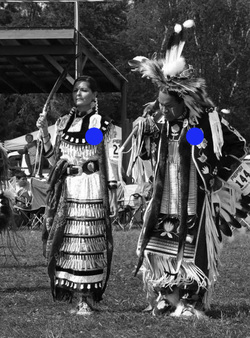
My paternal grandmother passed on a few days ago. I've been thinking a lot about her life in relation to mine, specifically what she taught me...lessons I live and practice but have never really connected back to her.
My grandmother was born on an island in the Mediterranean almost 100 years ago. She was born Elena Cubeddu and had no middle name.
More than anything else she loved her family. More than anything else she hated this land...Canada. I say this because she hardly ventured outside and I don't think a day went by that she didn't curse something related to the weather or topography. While my grandmother hated this land, she also loved this land because it made me possible...and she loved me. Tremendously. All her grandchildren. And she loved that I loved this land. And perhaps this contradiction was one of her greatest struggles.
What my grandmother also loved was a good dramatic love story. Stories of forbidden love, of unrequited love, of love that could transform villains into heroes. She really loved the T.V. kind that had steamy, scandalous sex scenes even though she would click her tongue, pretending to be all shocked and offended. Yes, she loved a good story and I think this is because she lived through and in stories...stories that spanned centuries.
When I was about 15 years old, she took me into her home for awhile. Until I was about 18 years old or so. Looking back at that time, I never really paid that much attention to how she was with other people... what she shared with her other grandchildren. I know she wasn't one to provide an immediate answer to any question. She always kept herself busy cooking, cleaning, and tidying up. But there were times in her kitchen when I would be sitting at the table eating and she would sit in her chair against the wall in front of the fridge and talk to me.
She never spoke about her life as a mother raising seven children. She never spoke to me about the old house that she used to live in in the south end. She never spoke about cooking or politics or friendships....What she did speak to me about during these times, was "her Sardinia".
I think she found a way back to her island through her stories and she wanted me to know that she existed apart from her children or grandchildren. During these times, she rarely shared stories about specific people or detailed events, but she would often go on about Sardinians as a whole...as proud, strong, cunning and resourceful people. She would talk about a people that were labeled as bandits, thieves, of "monkeys trying to imitate men" (as Dante once wrote in reference to Sardinians) but to her, were proud Sea People that had fought against pretty much all of southwestern Europe and the Middle East for their land and culture for over 1000 years.
My grandmother spoke about the land....about desert sand, salt winds and an inescapable heat that eventually all of its captives succumb to and learn to love (or at least tolerate). She spoke about lemon trees, honey, coral and prickly pears. She would go through lists of words and how to say them in Sardu. In her words, I learned about how her culture came from the water and how her Sardu language was in every wave that crashed in against the great cliffs of volcanic rock.
The truth is my grandmother taught me my first lessons about how tied we are to a place...what it means to be so connected that every minute spent away from your place takes a small part of you that you will never get back.
Most people fighting displacement don't really stop to analyze and theorize about it. They are too busy living it, making choices to oppose or accept it. They are too busy sharing their storied truths and surviving through memories. So long before I was introduced to the writings of all these celebrated intellectuals that I reference so often in my own scholarship, I had my grandmother's stories. I had her love of place through her stories.
She taught me some of the most pivotal teachings about love and place. She taught me that there will always be Sea People...and "land people" who fight to hear their language in the tides... who know that there is nothing more valuable than to bury your hot feet in the sand and be grounded in over 1000 years of people who fought for you to remember.
My grandmother was born on an island in the Mediterranean almost 100 years ago. She was born Elena Cubeddu and had no middle name.
More than anything else she loved her family. More than anything else she hated this land...Canada. I say this because she hardly ventured outside and I don't think a day went by that she didn't curse something related to the weather or topography. While my grandmother hated this land, she also loved this land because it made me possible...and she loved me. Tremendously. All her grandchildren. And she loved that I loved this land. And perhaps this contradiction was one of her greatest struggles.
What my grandmother also loved was a good dramatic love story. Stories of forbidden love, of unrequited love, of love that could transform villains into heroes. She really loved the T.V. kind that had steamy, scandalous sex scenes even though she would click her tongue, pretending to be all shocked and offended. Yes, she loved a good story and I think this is because she lived through and in stories...stories that spanned centuries.
When I was about 15 years old, she took me into her home for awhile. Until I was about 18 years old or so. Looking back at that time, I never really paid that much attention to how she was with other people... what she shared with her other grandchildren. I know she wasn't one to provide an immediate answer to any question. She always kept herself busy cooking, cleaning, and tidying up. But there were times in her kitchen when I would be sitting at the table eating and she would sit in her chair against the wall in front of the fridge and talk to me.
She never spoke about her life as a mother raising seven children. She never spoke to me about the old house that she used to live in in the south end. She never spoke about cooking or politics or friendships....What she did speak to me about during these times, was "her Sardinia".
I think she found a way back to her island through her stories and she wanted me to know that she existed apart from her children or grandchildren. During these times, she rarely shared stories about specific people or detailed events, but she would often go on about Sardinians as a whole...as proud, strong, cunning and resourceful people. She would talk about a people that were labeled as bandits, thieves, of "monkeys trying to imitate men" (as Dante once wrote in reference to Sardinians) but to her, were proud Sea People that had fought against pretty much all of southwestern Europe and the Middle East for their land and culture for over 1000 years.
My grandmother spoke about the land....about desert sand, salt winds and an inescapable heat that eventually all of its captives succumb to and learn to love (or at least tolerate). She spoke about lemon trees, honey, coral and prickly pears. She would go through lists of words and how to say them in Sardu. In her words, I learned about how her culture came from the water and how her Sardu language was in every wave that crashed in against the great cliffs of volcanic rock.
The truth is my grandmother taught me my first lessons about how tied we are to a place...what it means to be so connected that every minute spent away from your place takes a small part of you that you will never get back.
Most people fighting displacement don't really stop to analyze and theorize about it. They are too busy living it, making choices to oppose or accept it. They are too busy sharing their storied truths and surviving through memories. So long before I was introduced to the writings of all these celebrated intellectuals that I reference so often in my own scholarship, I had my grandmother's stories. I had her love of place through her stories.
She taught me some of the most pivotal teachings about love and place. She taught me that there will always be Sea People...and "land people" who fight to hear their language in the tides... who know that there is nothing more valuable than to bury your hot feet in the sand and be grounded in over 1000 years of people who fought for you to remember.

 RSS Feed
RSS Feed